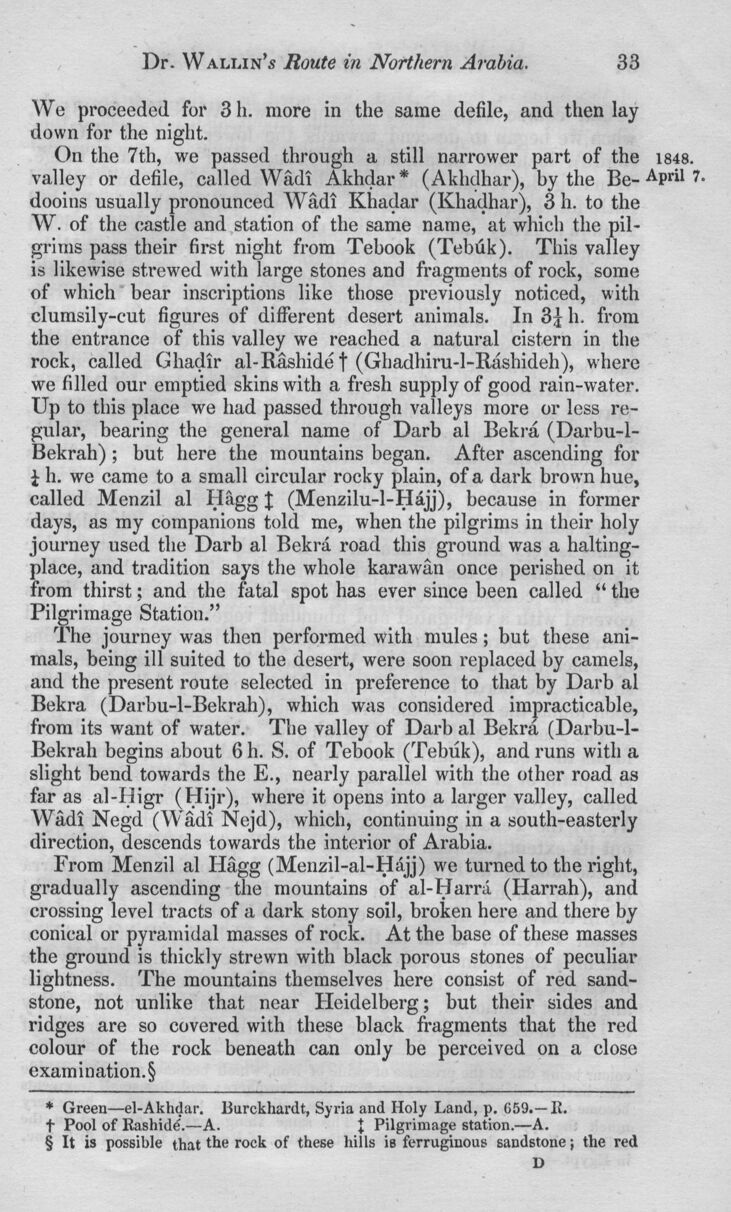
Full resolution (JPEG) - On this page / på denna sida - Route in Northern Arabia

<< prev. page << föreg. sida << >> nästa sida >> next page >>
Below is the raw OCR text
from the above scanned image.
Do you see an error? Proofread the page now!
Här nedan syns maskintolkade texten från faksimilbilden ovan.
Ser du något fel? Korrekturläs sidan nu!
This page has never been proofread. / Denna sida har aldrig korrekturlästs.
[-We-]{+Dr. Wallin’s Route in Northern Arabia.
33
We+} proceeded for 31i. more in the same defile, and then lay
down for the night.
On the 7th, we passed through a still narrower part of the
valley or defile, called Wadi Akhdar* (Akhdhar), by the
Be-dooius usually pronounced Wadi Ivhadar (Khadhar), 3 h. to the
W. of the castle and station of the same name, at which the
pilgrims pass their first night from Tebook (Tebuk). This valley
is likewise strewed with large stones and fragments of rock, some
of which bear inscriptions like those previously noticed, with
clumsily-cut figures of different desert animals. In h. from
the entrance of this valley we reached a natural cistern in the
rock, called Ghadir al-Rashide | (Gbadbiru-l-Rasbideh), where
we filled our emptied skins with a fresh supply of good rain-water.
Up to this place we had passed through valleys more or less
regular, bearing the general name of Darb al Bekra
(Darbu-1-Bekrah) ; but here the mountains began. After ascending for
i h. we came to a small circular rocky plain, of a dark brown hue,
called Menzil al Ilfigg J (Menzilu-l-Hijj), because in former
days, as my companions told me, when the pilgrims in their holy
journey used the Darb al Bekra road this ground was a
halting-place, and tradition says the whole karawan once perished on it
from thirst; and the fatal spot has ever since been called “ the
Pilgrimage Station.”
The journey was then performed with mules; but these
animals, being ill suited to the desert, were soon replaced by camels,
and the present route selected in preference to that by Darb al
Bekra (Darbu-l-Bekrah), which was considered impracticable,
from its want of water. The valley of Darb al Bekra
(Darbu-l-Bekrah begins about 6 h. S. of Tebook (Tebuk), and runs with a
slight bend towards the E., nearly parallel with the other road as
far as al-Idigr (Hijr), where it opens into a larger valley, called
Wadi Negd (Wadi Nejd), which, continuing in a south-easterly
direction, descends towards the interior of Arabia.
From Menzil al Hagg (Menzil-al-Hajj) we turned to the right,
gradually ascending the mountains of al-Harra (Ilarrah), and
crossing level tracts of a dark stony soil, broken here and there by
conical or pyramidal masses of rock. At the base of these masses
the ground is thickly strewn with black porous stones of peculiar
lightness. The mountains themselves here consist of red
sandstone, not unlike that near Heidelberg; but their sides and
ridges are so covered with these black fragments that the red
colour of the rock beneath can only be perceived on a close
examination.! * §
* Green—el-Akhdar. Burckhardt, Syria and Holy Land, p. 659.—11.
f Pool of Kashidd.—A. f Pilgrimage station.—A.
§ It is possible that the rock of these hills is ferruginous sandstone; the red
D
1848.
April 7.
<< prev. page << föreg. sida << >> nästa sida >> next page >>